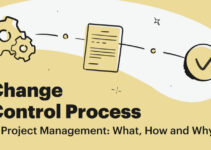Change control risk assessment offers you a well-structured and systematic approach to dealing with all types of risks associated with the change project. The objective is to make sure that you don’t make any unnecessary changes; in fact, you document all the changes and the attached risks for the efficient utilization of resources. Today, we’ll discuss change control risk assessment; various categories of changes; the structure of change control; its benefits, and a step-by-step guide for conducting and implementing it.
Change control risk is the main element of change management risk within information technology. the change control process comprises a series of steps starting from change request submission and others.
Categories of Changes in Change Control
- Scope Changes – customer’s request for new redesign and new features to improve the product
- Contingency Plan Implementation – reflecting changes in the baseline schedule or cost in case of occurrence of risk events
- Improvement Changes – project team members suggest the changes for improvement
Structure of Change Control Risk Analysis
- Recognizing the proposed changes
- Expected impact of the change project on the budget or schedule
- Approving, disapproving, analyzing, and reviewing the proposed changes
- Negotiating and managing the change conflict relevant to cost and conditions
- Discussing the change with impacted parties
- Allocating roles for the change execution
- Making adjustments to the budget and schedule
- Tracking all the executed changes
Benefits of Change Control Risk Assessment
- Risk avoidance and better cost
- The limited risk attached to every single change
- Decreasing the amount of time required for executing changes
- Implementing change with limited disruptions to the project schedule
- Informing the project managers about the required changes and developing a proper course of action
- A formal process discourages all the inconsequential changes
- Maintaining the log of the cost of changes
- Maintaining the performance and integrity of WBS
- Budget allocation and tracking the reserve funds
- Clarifying the implementation responsibilities and obligations
- The impact of changes is transparent to all the parties and stakeholders
- Monitoring and analyzing the change implementation
- The baseline would reflect the performance measures and scope changes
Change control risk assessment is the method of documenting, managing, and analyzing all the changes and associated risks that would impact the efficacy, safety, and quality of the change project product or processes. It makes sure that you comply with all the regulatory requirements and decreases the risk factors and deviations.
Conducting Change Control Risk Assessment
Let’s discuss the steps involved in implementing and conducting the change control risk assessment and they’re as follows;
Recognizing Change
First of all, you should clearly outline the rationality of the change project, its scope, and its objectives. It is necessary to know and recognize the proposed changes; their reason for the change, and how it would impact the product or processes.
- Assigning roles and responsibilities of the change owners
- Selecting the change initiators and change approver
- Documenting the change requests
- Recording the change control processes
Studying the Impact
Secondly, you should analyze the impact of the change project on product, process, efficacy, safety, and quality. It is significant to keep in mind the both direct and indirect impact of the change plan on the following;
- Product specification
- Regulatory compliance
- Documentation
- Validation
- Personal
- Environment
- Material
- Equipment
- Process parameters
- Product specification
You should recognize the potential risk factors associated with the change project like; deviation, errors, failures, mix-ups, and cross-contamination.
Analyzing the Risk
Thirdly, you should evaluate and monitor the risk factors attached to the change project. You could employ the following risk assessment tools, methods, and strategies;
- HACCP (hazard analysis and critical control points)
- FMEA (failure mode and effects analysis)
You should analyze the severity and probability of every risk factor and assign every risk with a specific rating and score. While doing so, you should know the risk acceptance criteria like; higher, lower, or medium risks.
Risk Mitigation
Fourthly, you should decrease the mitigate the risk factor attached to changes. You should recognize and execute any measures and actions that would decrease the hazard or risk factor; some of them are as follows;
- Prevention control
- Corrective actions
- Contingency plan
- Additional testing
You should validate and evaluate the effectiveness of the risk mitigation measures and actions; and record the results of the risk mitigation strategies.
Discussing Risk
Fifthly, you should communicate and discuss the risk factors associated with the change project. You should consult and inform the relevant stakeholders and they’re as follows;
- Customers
- Regulatory affairs and authorities
- Validation
- Maintenance and engineering
- Product and quality control
- Quality assurance
- Change approver
- Change initiators
- Owners of change project
It is significant to provide the right and clear information about the mitigation measures and actions, risk, impact, and change.
Reviewing & Change Approval
Finally, you should approve and analyze all the changes. You should make sure to document and complete all the steps involved in the risk assessment process. While doing so, you should make sure that you have verified and executed all the risk mitigation measures and actions. You need approval from the change project approver; who has the obligation of making sure that the change is compliant, feasible, and justified. However, you should maintain and update the change control documents and other relevant records.
Conclusion: Implementing & Conducting Change Control Risk Assessment
After an in-depth study of the change control risk assessment; we have realized that the change control plays a key role in managing the change project. If you are learning about the change control risk assessment; then you should keep in mind the abovementioned elements, benefits, categories, and steps involved in the process of conducting change control risks analysis.
Ahsan is an accomplished researcher and has a deep insight in worldly life affairs. He goes Live 3 days a week on various social media platforms. Other than research writing, he’s a very interesting person.


